Why the Jelly Belly Factory Has a Shrine to Ronald Reagan
The Gipper loved his sweet, sweet beans.

There’s plenty to do at the Jelly Belly factory, located at 1 Jelly Belly Lane in Fairfield, California. After donning a mandatory paper hat, you can take a tour, peering over a guardrail at the factory floor as machines crank out endless flats of colorful jelly beans. Afterwards, line up for your free sample of one of their dozens of flavors—you can even try the weird ones, like earwax and vomit. Peckish? Don’t miss the cafe, where you can enjoy a bean-shaped pizza or burger. But whatever you do at the factory, you’ll be watched over by the presence of former President Ronald Reagan. He’s everywhere. The line for the tour meets in front of a cabinet filled with Reagan memorabilia. He’s smiling down from a portrait of him made from jelly beans. During the tour, guests stop in front of a wall covered with a dozen photos of him.
The company, and the family that owns it, are obviously fans of the Gipper. But when Reagan first encountered Jelly Belly, he was the fan.
Reagan appeared in ads for Chesterfield cigarettes in the ‘40s and ‘50s, but his vice of choice was pipe smoking. He quit sometime before the late 1960s, when he started running for governor of California. By then, he had settled on a stand-in: jelly beans. At a 1966 campaign event, a man named Russ Albers struck up a conversation. Had Reagan tried a new, more gourmet type of jelly bean from an Oakland company, a brand that Albers happened to carry in his stores? Reagan tried one, and soon, he was hooked.
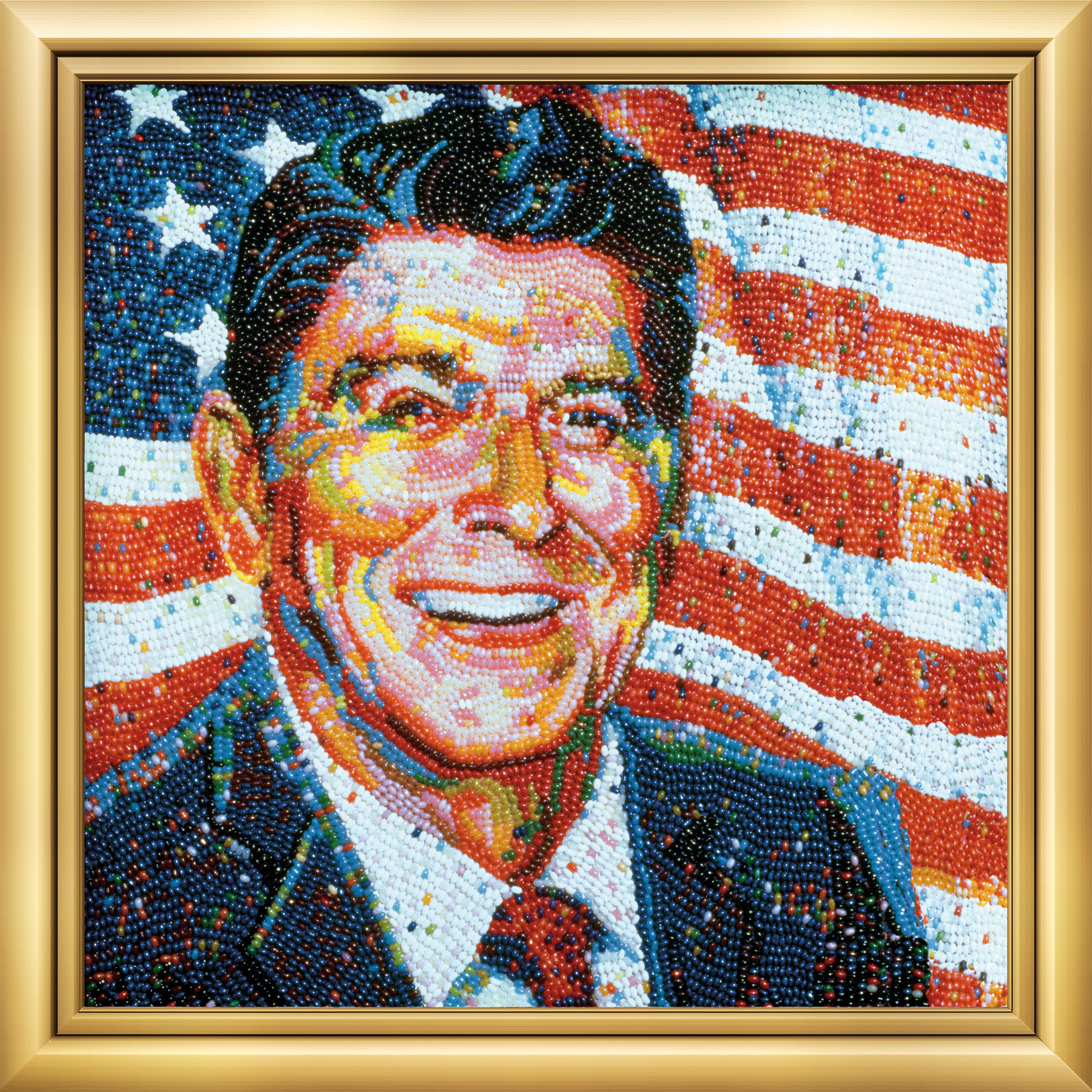
That’s because those beans—from the Goelitz Candy Company, now renamed Jelly Belly—were different than others on the market. At the time, the flavoring in standard jelly beans was limited to their outer shells. The inside was just a mass of chewy sugar. The Goelitz company changed that, shrinking their beans and adding flavor to the interior.
Soon, Reagan started getting these smaller, more flavorful jelly beans shipped to his Sacramento governor’s office. He kept a jar on his desk, sometimes filled with licorice beans, his favorite flavor. In a letter to the company, he wrote that “They have become such a tradition of this administration that it has gotten to the point where we can hardly start a meeting or make a decision without passing around a jar of jelly beans.”
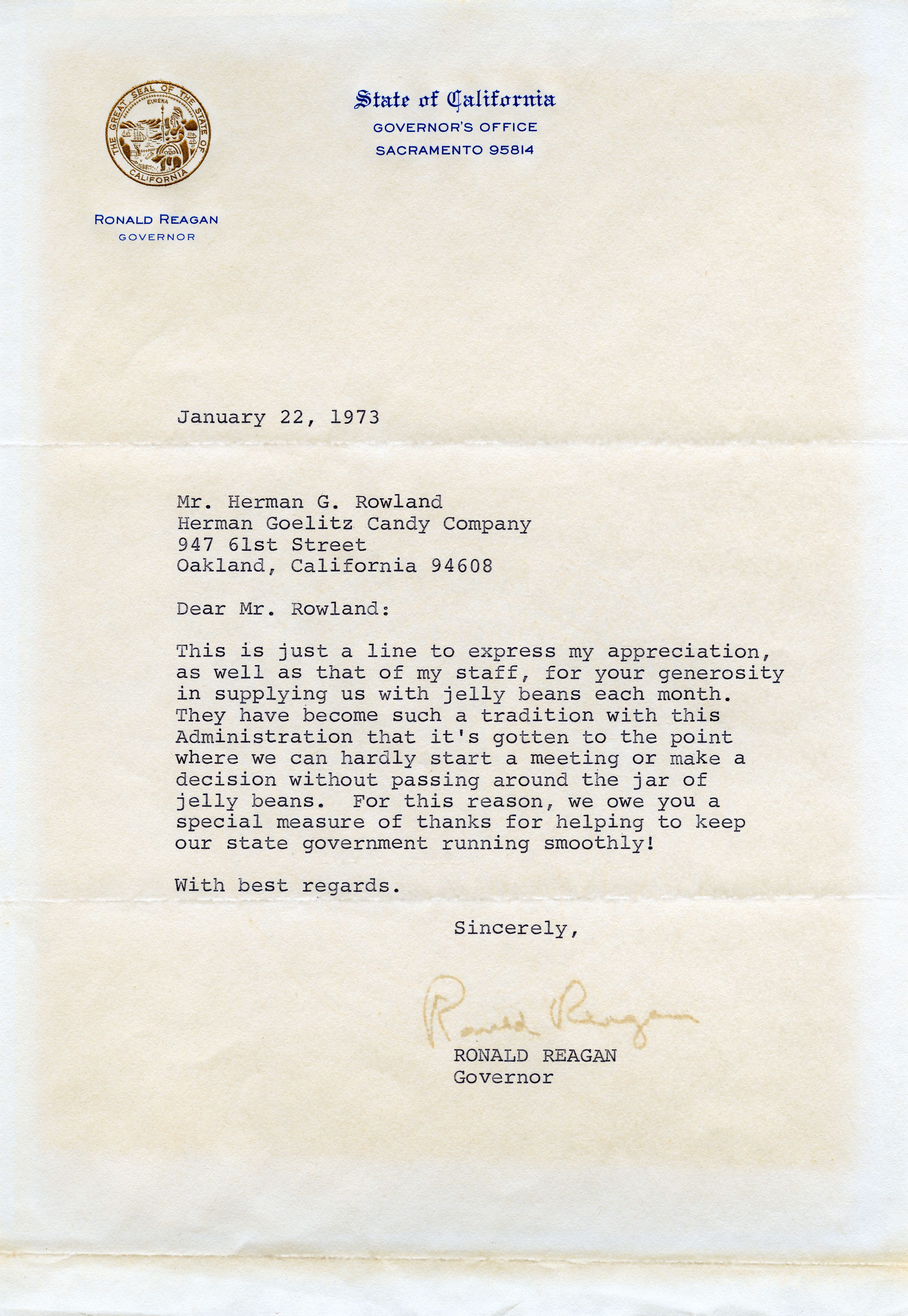
In the ‘70s, California Assemblyman Willie Brown got into a screaming match with Reagan. “In anger, Brown thrust his hand into Reagan’s legendary jelly bean jar and then declared that he knew that neither Reagan nor his staff would eat the jelly beans because his black hand had been inside,” wrote James Richardson in Willie Brown: A Biography.
The company didn’t publicize the connection, and quietly supplied Reagan with beans throughout his gubernatorial career. In 1980, a journalist from Time snapped a photo of Reagan eating the beans in his hotel during a presidential campaign stop. The Jelly Belly logo was clearly visible in the picture. “It ended up in a newspaper article, and we were like, oh no,” Jelly Belly president and CEO Lisa Rowland Brasher says. “Our phone started ringing off the hook with people wanting to talk with us and know about [our] relationship with Reagan.” The small, family-owned company was quickly overwhelmed with orders, receiving so many that at one point they were 77 weeks behind in production. Reagan’s influence was so great that the company’s profits doubled the year after it was discovered he ate Jelly Bellys. Eventually, they built a new facility to keep up with demand.
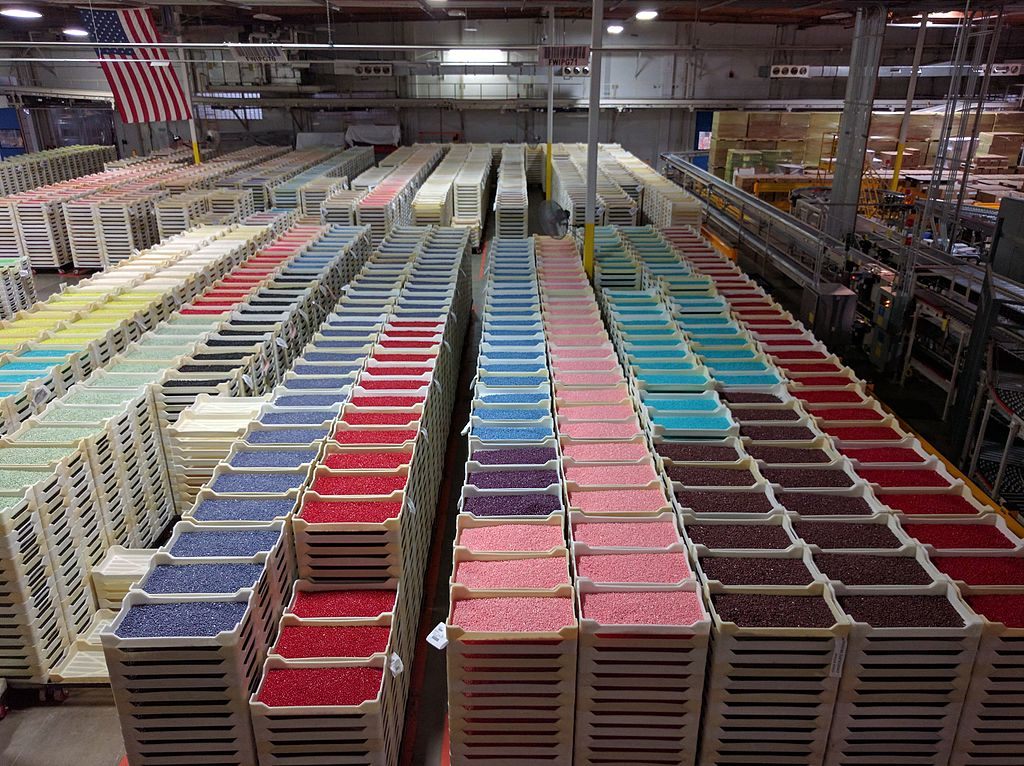
Next year, the company received a call. Could they supply jelly beans for Reagan’s presidential inauguration? Of course, they said. The inauguration planners wanted patriotic beans, which the company was able to provide with a mix of red (Very Cherry) white (coconut) and blueberry beans. They ended up sending three-and-a-half tons of beans to the inauguration.
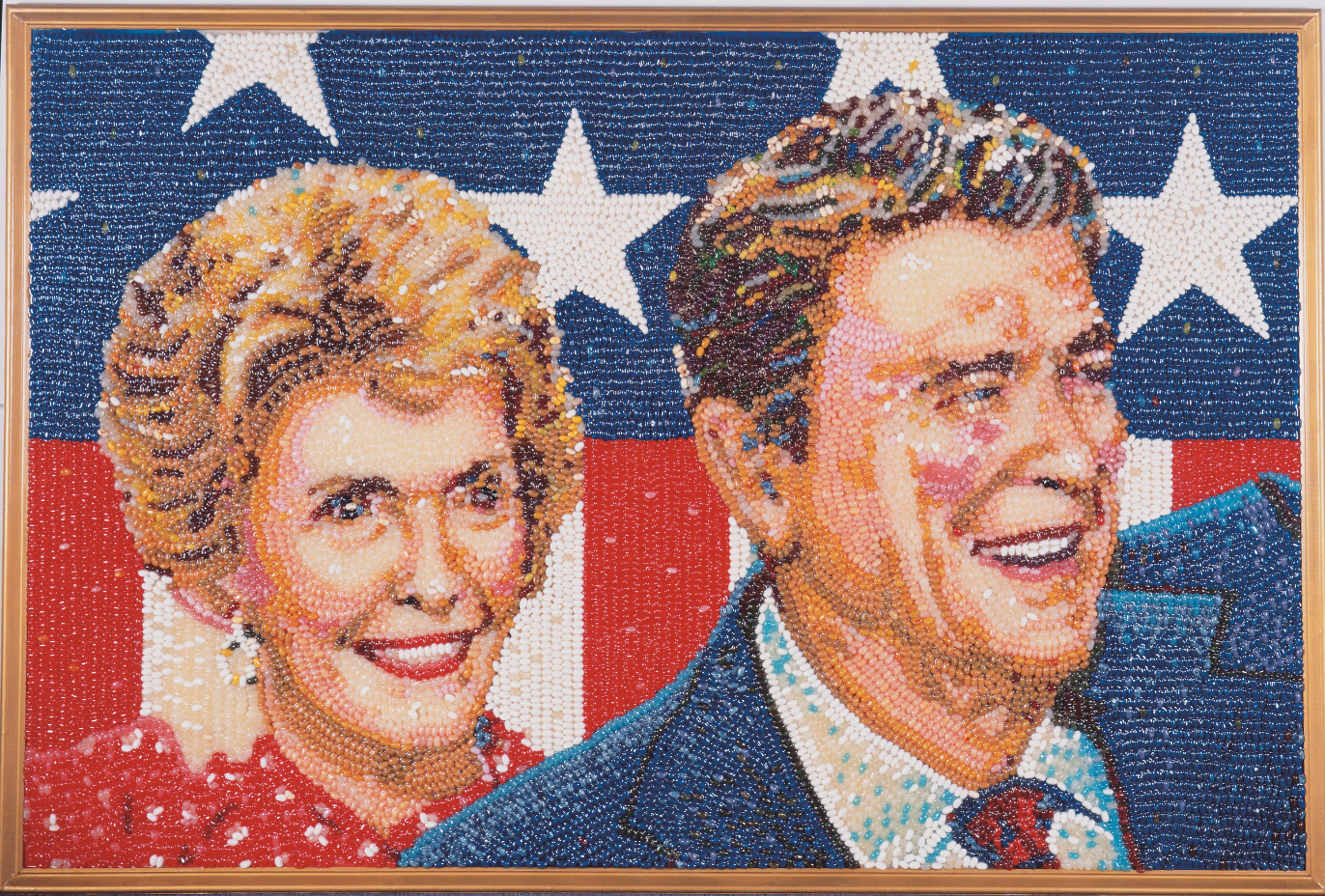
Jelly beans became an integral part of Reagan’s public image. He placed a standing order for 720 bags of beans per month to distribute throughout government buildings, and ate them in the Oval Office, on Air Force One, and with heads of state. He allowed the company to start producing jars of jelly beans with the presidential seal, and gave them out to dignitaries, later bestowing one on Bill Clinton during the latter’s inauguration. In cabinet meetings, they served as a test of character: “You can tell a lot about a fella’s character by whether he picks out all of one color or just grabs a handful,” he told interviewers. He even sent some up with the astronauts on the Challenger space shuttle.
Towards the end of his presidency, Reagan switched allegiance to M&Ms, which became the official candy of the White House. (“Absolutely not,” Brasher says with a laugh, when asked if Jelly Belly bears any ill will toward Mars for poaching their most famous customer. “I love M&Ms.”) And after he left office, the Jelly Belly company stopped supplying the White House with beans.

Over the years Jelly Belly expanded from the small company that Reagan helped popularize. Now, they produce around 15 billion beans a year. But every once in awhile, their connection to Ronnie resurfaces. After Reagan’s death, the company placed black ribbons over jelly bean portraits of him hanging in the factory, and journalists asked Jelly Belly executives for their thoughts. In 2011, Republican presidential candidate Rick Santorum did a stump speech at the factory in an unsuccessful attempt to evoke some of Reagan’s popularity. These days, most of the children visiting the factory, eyes wide at the prospect of free candy, don’t know or care who the portrait of the man in the cowboy hat is. But their parents usually recall the former president’s candy addiction.
“The older generations that come through, they definitely remember, ‘Oh yeah, that was President Reagan’s favorite candy,’” Brasher says. “I think it’s just something fun and lighthearted. It doesn’t have to be political. Isn’t that nice nowadays?”
Gastro Obscura covers the world’s most wondrous food and drink.
Sign up for our email, delivered twice a week.






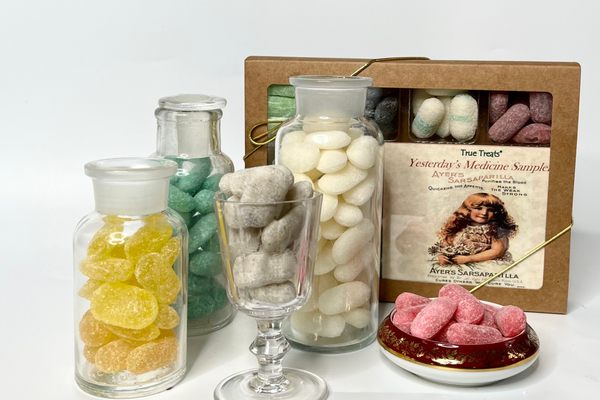


























Follow us on Twitter to get the latest on the world's hidden wonders.
Like us on Facebook to get the latest on the world's hidden wonders.
Follow us on Twitter Like us on Facebook